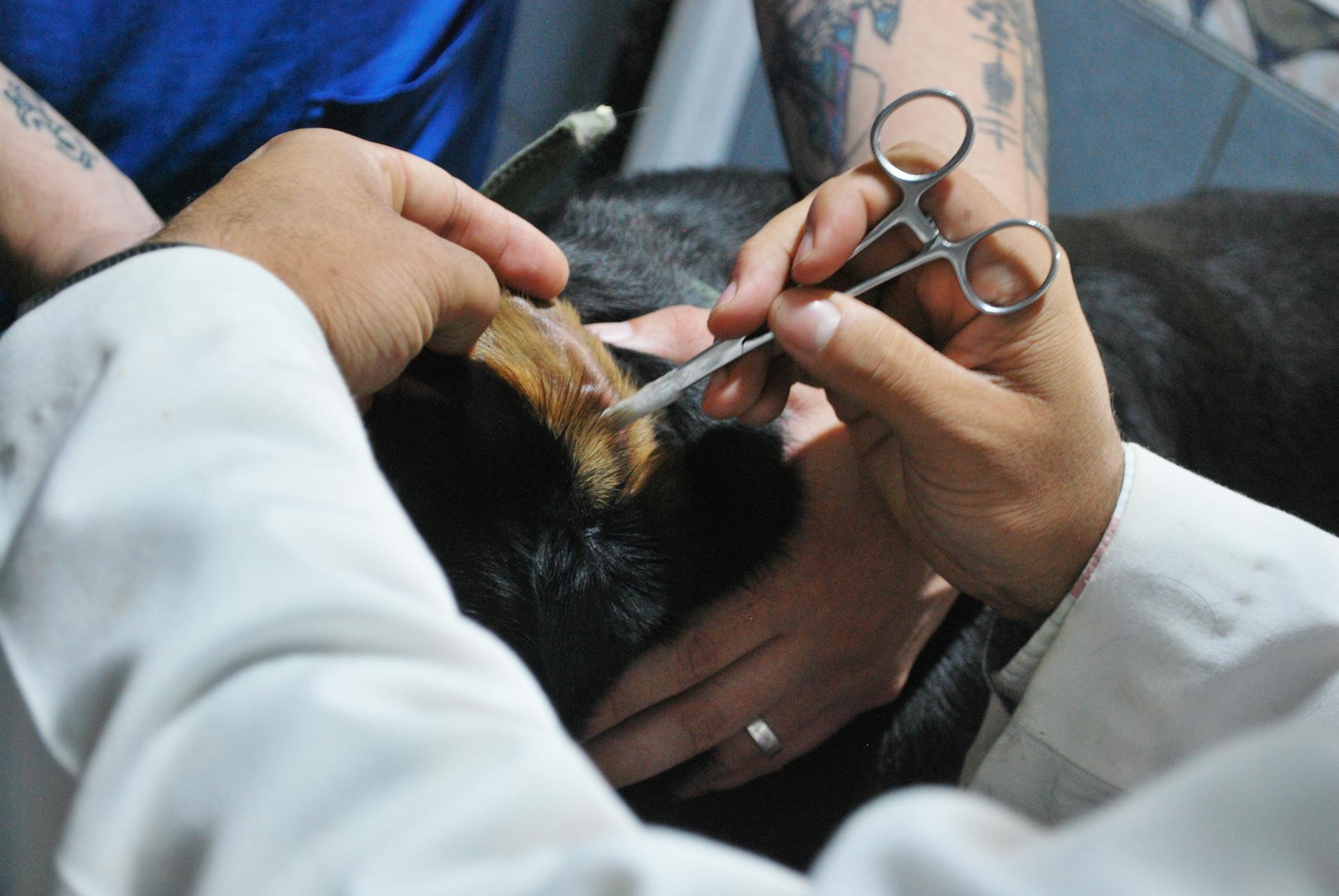
The Canis Familiaris genus is a fascinating group of animals. It belongs to the family Canidae, which also includes wolves, foxes, and jackals.
Canis Familiaris is a domesticated species that has been selectively bred for thousands of years, resulting in a wide range of breeds with varying characteristics.
The scientific name Canis Familiaris was first used by Carl Linnaeus in 1758.
For another approach, see: Canis Lupus Familiaris Species
Classification
The classification of Canis familiaris, also known as the dog, is a complex process that involves several levels of categorization.
The kingdom Animalia is the broadest category, encompassing all animals, including dogs.
The phylum Chordata is a more specific category, which includes animals with a notochord, a dorsal nerve cord, and a post-anal tail, characteristics that dogs possess.
Vertebrata is a subphylum within Chordata, which includes animals with a backbone, a feature that dogs also have.
Mammalia is a class within Vertebrata, which includes warm-blooded animals that give birth to live young, characteristics that dogs exhibit.
Carnivora is an order within Mammalia, which includes meat-eating mammals, a dietary characteristic that dogs possess.
Canidae is a family within Carnivora, which includes dogs, wolves, and other related species.
Canis is a genus within Canidae, which includes dogs, jackals, and wolves, all of which are closely related species.
The species Canis lupus is a closely related species to Canis familiaris, and is also known as the gray wolf.
Here is a summary of the classification levels for Canis familiaris:
Physical Characteristics
Canis familiaris, the domestic dog, is a medium-sized canine with a muscular build and a short, smooth coat that comes in a wide range of colors and patterns.
Their average weight is between 20-70 pounds, depending on the breed and size.
A typical adult dog stands between 10-20 inches tall at the shoulder.
Their ears are usually erect and triangular in shape, with a rounded tip.
Teeth
Dogs have two sets of teeth. 28 deciduous teeth are replaced by 42 adult teeth by six to seven months.
Dogs use their teeth for various functions. Their incisors are used for chewing and nibbling, while canines are used for tearing flesh.
Their premolars and molars are designed for shearing and crushing. This is likely why you'll see your furry friend using their back teeth to crunch on a bone or chew through a tough treat.
Here's a breakdown of a dog's teeth:
- Incisors: used for chewing and nibbling
- Canines: used for tearing flesh
- Premolars and molars: used for shearing and crushing
Skeletal System
Dogs have a unique skeletal system that's worth noting. They have 319 bones, though this number can be lower if their tail is docked or missing.
Their skeletal system is designed to support their body weight, and it's impressive to see how it works. Muscles support half of their body weight, which is a remarkable feat.
Upper body muscles are more developed in dogs, which is likely due to their natural behavior of running and playing. This means they have stronger arms and shoulders compared to other parts of their body.
If this caught your attention, see: Food to Help Dogs Gain Weight
Senses and Behavior
Dogs have five senses similar to humans, but their sense of smell is particularly superior. This incredible sense is used for various tasks like finding missing people.
Their sense of smell is so powerful that it's used to locate harmful materials like gases that are invisible to humans. This ability makes them invaluable in search and rescue missions.
Here are some key facts about a dog's sense of smell:
- They have up to 300 million olfactory receptors in their noses, compared to only 6 million in humans.
- Their sense of smell is so strong that they can detect scents that are too faint for humans to detect.
With their incredible sense of smell, it's no wonder that dogs are often used to detect narcotics, explosives, and other substances.
Habitat and Distribution
Dogs claim territory based on owner restrictions, while wolves have vast territories for hunting.
Dogs mark the limits of their territories by peeing and leaving their scent on the ground or on trees.
In reality, most dogs live within the confines of their owner's property, whereas wolves roam freely across vast areas in search of prey.
Dogs tend to be more territorial than wolves due to their domestication and dependence on humans.
Here's a comparison of the two:
Relationship with Other Canines
The Canis familiaris genus is closely related to other canines, including the Canis lupus species, which is actually the gray wolf. This is evident from the fact that Canis lupus is listed as a related species in the same article.
Canis familiaris and Canis lupus are both part of the Canidae family, which is a group of carnivorous mammals that also includes foxes and jackals. The Animal Diversity Web doesn't cover all species in the world, but it does provide a wealth of information on the relationships between different species.
In fact, the Canis lupus species is often considered to be the ancestor of the Canis familiaris genus, with many scientists believing that dogs were domesticated from gray wolves thousands of years ago.
Related reading: Gray Bernedoodle
Lifespan and Development
Dogs can live up to 27 years, with some exceptional cases reported to be around 30 years old.
The lifespan of dogs varies greatly depending on their breed, with smaller breeds generally living longer and aging slower. This is likely due to their slower growth rates.

Smaller breeds such as Miniature Poodles, Bearded Collies, Border Collies, and Miniature Dachshunds are known to live longer than larger breeds like the Dogue de Bordeaux and Great Dane.
Dogs are considered old at around 12 years of age, but with proper care, some can live well into their teens.
Caloric restriction has been shown to increase median lifespan and improve physiological function in dogs, similar to its effects in humans.
As dogs age, they are prone to various degenerative conditions and age-related diseases, including cancer, cardiac disease, hearing loss, cataracts, and senile dementia.
Older dogs also experience cognitive decline and accumulation of amyloid plaques, similar to humans.
Inflammaging is a common issue in aging dogs, leading to increased inflammation and oxidative stress damage.
Telomere length is a strong predictor of longevity in dogs, and there may be a connection between extremely-aged dogs and the mechanisms around gene transcription/translation.
Here's an interesting read: Liver Mini Schnauzer
Contents and Taxonomy
The Canis familiaris genus is a fascinating topic, and understanding its taxonomy is essential to appreciating its diversity. Over 70 subspecies exist within the genus Canis.
One of the most interesting aspects of the Canis familiaris genus is its classification within the animal kingdom. It belongs to the domain Eukaryota, which includes all organisms with complex cells.
Let's take a closer look at the hierarchy of the Canis familiaris genus. Here's a breakdown of its classification:
The Canis familiaris genus is a part of the Canidae family, which includes dogs, wolves, and foxes.
Frequently Asked Questions
Can all Canis interbreed?
Yes, all Canis species can interbreed due to their close phylogenetic relationship. However, the success of interbreeding may vary depending on the specific species involved.
What are the 7 levels of classification for a dog?
A dog's full classification consists of 8 levels, not 7, but here are the top 7 levels: Eukarya, Animalia, Chordata, Mammalia, Carnivora, Canidae, and Canis. Understanding these levels can help you appreciate the dog's unique place in the animal kingdom.
Sources
- https://www.geeksforgeeks.org/scientific-name-of-dog/
- https://animaldiversity.org/accounts/Canis_lupus_familiaris/classification/
- https://genomics.senescence.info/species/entry.php
- https://prehistoric-wiki.fandom.com/wiki/List_of_species_and_subspecies_in_the_genus_Canis
- https://pubmed.ncbi.nlm.nih.gov/23124015/
Featured Images: pexels.com


